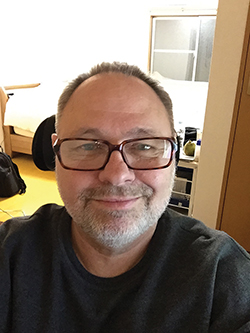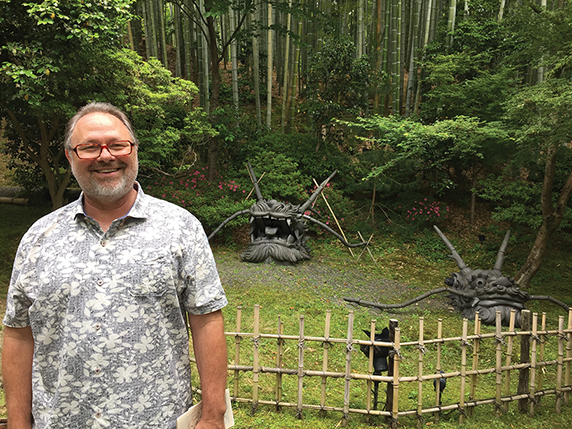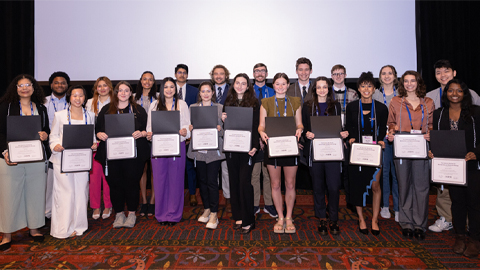Meet Timothy Karr
Sperm fascinate Timothy Karr. A postdoctoral stint with Bruce Alberts in the early 1980s changed Karr’s interests from the biochemistry and biophysics of polymers to the developmental and genetic contributions of sperm to the reproduction and evolution of a species. These days, Karr, a visiting scientist at the Kyoto Institute of Technology in Japan and an adjunct professor at Arizona State University, is analyzing the molecular changes that happen to mammalian sperm as they travel through the male reproductive system and become capable of fertilizing an egg.
 Karr studies how sperm changes on a molecular level as it makes its way through the reproductive system.PHOTOS COURTESY OF TIM KARR
Karr studies how sperm changes on a molecular level as it makes its way through the reproductive system.PHOTOS COURTESY OF TIM KARR
Karr recently became an associate editor for the journal Molecular & Cellular Proteomics, which is published by the American Society for Biochemistry and Molecular Biology. Rajendrani Mukhopadhyay, the ASBMB’s chief science correspondent, spoke with Karr to learn about his research interests and career trajectory. The interview has been edited for length and clarity.
What is your research about?
We’re looking at using proteomics to follow the changes that occur in sperm composition during their transit through the epididymis as they acquire fertilization competency. (Author’s note: The epididymis is the duct through which sperm moves before exiting the body. It’s present in male mammals, birds and reptiles.)
How did you become interested in sperm maturation?
As an insect development biologist, I learned that sperm are a central element of all animal and plant organismal fitness. As I started learning more about reproductive biology, it became clear that the maturation process (of sperm) is still a very mysterious one and complicated. The journey that sperm make (through the male reproductive system) is essentially unknown in terms of molecular details. The work has practical implications (for fertility) along with the plain-old fact that I like to make biological discoveries.
Why do proteomics? What can it do that other methodologies can’t?
There are some systems you can learn about only by doing proteomics because transcriptomics is a minor player. Sperm are made by the testes, which is a very complex organ that transcribes a very large number of genes, of which only a fraction end up in the sperm. Doing the transcriptome of the testes confuses you as to what’s actually in the sperm. Sperm are made of predominantly proteins and lipids and other things, but, in terms of transcription, they are mostly silent. People are starting to realize they can leapfrog over the transcriptomic analysis and directly analyze the protein components in sperm.
We have begun trying to connect the dots between what is changing in sperm and how they acquire the ability to fertilize at the proteomic level. The hope is that it will lead us to a focus on important components of this system that could be used for further studies of reproduction.
How did you become interested in science?
It was a natural consequence of the way I grew up. I grew up in the middle of central Arizona, about 60 miles from Phoenix, near the Agua Fria River, away from civilization. I had exposure to a lot of desert nature. A young child’s fascination with the creepy-crawlies, the noises at night and the animals — I was immersed in it. I didn’t have a choice. I naturally gravitated toward curiosity-driven understanding of the world.
The Arizona desert is quite hot. We didn’t have electricity and air conditioning. In the summer, I remember there was a flat rock. I would take water out from the well, pour it on the rock and watch how fast it evaporated. I still remember how fascinated I was, toying around with the conditions under which (evaporation) would happen. I remember observing nature and trying to put rational thinking behind it.
What did your parents do?
They mined gold. It was a way to accumulate enough gold to go into town and trade it for food and stuff. It wasn’t for money making or profit making. It was subsistence living. It was no-electricity, no-running-water kind of existence. We grew some of our own food. We had goats for milk. We had donkeys to haul water.
When the sun went down, we were inside. The school that we went to was a one-room school with eight grades. Once a month, the book mobile would come by, a large, old-style Winnebago filled with books. I would get a huge stack of books. I loved to read, and my sister loved to read also. Between the time the sun went down and the time we went to bed, I read. That also had a huge influence on me. I gravitated toward books about science and scientists.
Where did you go to college?
I had a scholarship to Stanford. But when I got there, I couldn’t go because I couldn’t afford it. I ended up going to a junior college nearby, because I had to work to support myself for a couple of years before transferring to (the University of California), Santa Barbara. I did my undergraduate, and then I obtained my Ph.D. in the chemistry department at UC Santa Barbara.
Who was your adviser?
His name is Daniel Purich. He’s at the University of Florida now, and he’s still doing lots of wonderful things. He’s the reason I’m here.
What did he do?
He was a fantastic mentor and never let me believe, for one second, that I’d made a wrong decision for going into science. He’s so inclusive in his desire to bring people in and encourage them.
What happened after your Ph.D.?
I did a postdoc with Bruce Alberts at (the University of California, San Francisco) and also Thomas Kornberg at UCSF. I did two postdocs over the course of about five years before I took my first academic position (at the University of Illinois).
 While a visiting scientist at the Kyoto Institute of Technology in Japan, Karr takes in the scenery near Kyoto’s Ryozen Gokoku Shrine.
While a visiting scientist at the Kyoto Institute of Technology in Japan, Karr takes in the scenery near Kyoto’s Ryozen Gokoku Shrine.
How did you start working on sperm?
I went to Bruce’s lab to work on T4 DNA replication. I had done my thesis work on microtubules but strictly from a biophysical and biochemical standpoint. I wanted to continue working on systems that polymerized. Bruce had done unbelievable work in the area of (DNA replication), so I was fortunate enough to get into his lab and start working on that for my first year. Then Bruce decided to work on Drosophila, so I was one of his point people to get that jump-started in his lab.
I knew nothing about developmental biology or genetics. It was like doing another Ph.D. It was great and wondrous, remaking myself as a developmental biologist. During that process, I (learned) that Drosophila make very long sperm. Sperm gigantism had been noted for 100 years … These sperm are as long as the male.
I discovered that this whole sperm entered the egg intact and formed a structure in the egg. It was a rather stunning discovery. Using cell biological techniques including 3-D microscopy, I published, in 1991, the first three-dimensional reconstruction of sperm in a fertilized egg.
But the paternal product in the egg was (considered) an anomaly. I had a bit of an uphill struggle, and, until I went to England, I never got funding for this work. It had a negative impact on my career, because nobody understood (paternal effects in fertilization) and nobody wanted to hear about it. Because I couldn’t get funding, I couldn’t make enough progress to satisfy anybody. With the new and emerging idea of epigenetics of paternal products, I’ve been able move forward.
I also became interested in Wolbachia, because I was constantly trying to think of ways to show that the father provides more to the fertilized egg than just DNA. (Author’s note: Wolbachia is a genus of bacteria that infects insects and some nematodes. It is one of the world’s most common parasitic reproductive microbes, because it gets passed along from one generation to the next through insect and nematode reproductive systems.)
Why did you go to England?
They gave me money to study sperm. There was a person who had taken notice of me when I published a couple of Nature papers on Wolbachia. He was a theoretical biologist who had written part of his thesis about Wolbachia, and he was fascinated that somebody actually had done experimental work on it. A couple years later, he contacted me and said, “We have an opening here. Are you interested?”
I was at the University of Chicago at the time. One of the evolutionary biologists from Chicago had recently moved to Edinburgh. He and a couple others decided to support the (University of Bath’s) application to get me a Royal Society Wolfson Research Merit Award.
The Royal Society agreed. I had a five-year window with a healthy chunk of money and a salary, because the Royal Society also said they would match my salary at Chicago. It was wonderful. I continued my Wolbachia and sperm work unabated for a few years.
What brought you back to the States?
I wish I was still there. But it didn’t work out for the family for a number of reasons. It was the worst possible time (to move back) from a funding standpoint, because it was 2008. Our country was financially bleeding to death. It was very difficult to get a senior-level job. They wouldn’t let me bring my money from the U.K. I was stuck.
But I had made a commitment to my family, which is far more important than being a professor at the University of Bath. I went back to Arizona and was fortunate enough to get a research position at (Arizona State University) and continue to be productive.
What do you think you bring to the table as an MCP associate editor?
The field of proteomics has been highly technologically driven. MCP is distinguished by the fact that it also promotes cellular function. Protein biology is so much more complex than (that of) nucleic acids at the chemical level that it’s been a huge challenge to get traction on the technology. I really like the idea of using the technology to discover new things about systems that are involved in evolution, development and reproduction. We are garnering new insights into aspects of human diseases through the evolutionary lens. I think that angle is very important for the journal, and it’s something I will try to promote. People should be comfortable with applying these powerful technologies to fundamental questions about evolution and development.
What advice would you give younger scientists?
I can only use myself as an example. I never wanted to do anything else. I never would discourage anybody from wanting a life of discovery. The only mark I can leave is if I discovered something. The rest follows along. I’ve been bruised and battered by the academic system. I’ve had commensurate financial complications. But I never, for a second, ever thought about not doing it. It’s the only reason I’m still here.
Enjoy reading ASBMB Today?
Become a member to receive the print edition monthly and the digital edition weekly.
Learn moreGet the latest from ASBMB Today
Enter your email address, and we’ll send you a weekly email with recent articles, interviews and more.
Latest in People
People highlights or most popular articles

ASBMB inducts new honor society members
Chi Omega Lambda, which recognizes exceptional juniors and seniors pursuing degrees in the molecular life sciences, has 31 inductees in 2024.

2024 voter guide
Learn about the candidates running for ASBMB Council, Nominating Committee, Publications Committee and treasurer.

Charles O. Rock (1949 – 2023)
Colleagues and trainees remember a world expert in membrane lipid homeostasis.

Honors for Clemons, Hatzios and Wiemer
Awards, honors, milestones and more. Find out what's happening in the lives of ASBMB members.

Touching the future from the bench
Scholar, scientist, teacher and mentor Odutayo Odunuga discusses the important roles of the institutional PI, his journey and his research.

In memoriam: Darwin Prockop
He held leadership positions at multiple institutions and was known for his contributions to adult stem cell biology and cellular biology.

